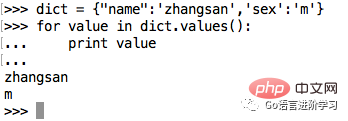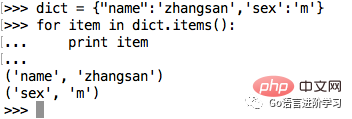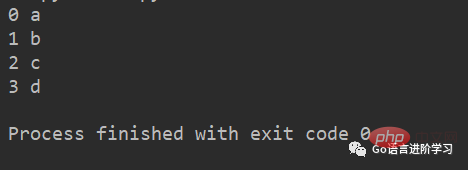 Backend Development
Backend Development
 Python Tutorial
Python Tutorial
 An article to help you understand the basic dictionary knowledge of Python
An article to help you understand the basic dictionary knowledge of Python
An article to help you understand the basic dictionary knowledge of Python
1. Foreword
If there is a list and the name "xiaoWang" needs to be written incorrectly, the code must be modified through the corresponding index value.
nameList = ['xiaoZhang', 'xiaoWang', 'xiaoLi'] nameList[1] = 'xiaoxiaoWang
If the order of the list has changed, as follows:
nameList = ['xiaoWang', 'xiaoZhang', 'xiaoLi']
At this time You need to modify the subscript to complete the name modification.
nameList[0] = 'xiaoxiaoWang'
#Is there any way to store multiple data and locate the required one easily while accessing the elements? What about that element? This is the dictionary.
## 2. Introduction to the dictionary
-
Dictionaries, like lists, can also store multiple data.
#When looking for an element in the list, it is based on the subscript.
When looking for an element in the dictionary, it is based on the 'name' (that is, the value in front of the colon:, such as 'name', ' id', 'sex').
#Each element of the dictionary consists of 2 parts, key: value. For example, 'name':'monitor', where 'name' is the key and 'monitor' is the value.
Access value based on key
Example:
# #
info = {'name':'班长', 'id':100, 'sex':'f', 'address':'地球亚洲中国北京'}
print(info['name'])
print(info['address'])若访问不存在的键,则会报错:
>>> info['age'] Traceback (most recent call last): File "<stdin>", line 1, in <module> KeyError: 'age'
在我们不确定字典中是否存在某个键而又想获取其值时,可以使用get方法,还可以设置默认值。
>>> age = info.get('age') >>> age #'age'键不存在,所以age为None >>> type(age) <type 'NoneType'> >>> age = info.get('age', 18) # 若info中不存在'age'这个键,就返回默认值18 >>> print(age) 18 #运行结果
1. 字典的常见操作
<1> 添加元素
info = {'name':'班长', 'sex':'f', 'address':'地球亚洲中国北京'}
print('id为:%d'%info['id'])运行结果:

如果在使用 变量名['键'] = 数据 时,这个“键”在字典中,不存在,那么就会新增这个元素。
添加新的元素。
info = {'name':'班长', 'sex':'f', 'address':'地球亚洲中国北京'}
# print('id为:%d'%info['id'])#程序会终端运行,因为访问了不存在的键
newId = input('请输入新的学号')
info['id'] = newId
print('添加之后的id为:%d'%info['id'])运行结果:
请输入新的学号188 添加之后的id为: 188
<2> 删除元素
对字典进行删除操作,有一下几种:
del
clear()
del删除指定的元素
info = {'name':'班长', 'sex':'f', 'address':'地球亚洲中国北京'}
print('删除前,%s'%info['name'])
del info['name']
print('删除后,%s'%info['name'])运行结果:

del删除整个字典。
info = {'name':'monitor', 'sex':'f', 'address':'China'}
print('删除前,%s'%info)
del info
print('删除后,%s'%info)运行结果:

clear清空整个字典。
info = {'name':'monitor', 'sex':'f', 'address':'China'}
print('清空前,%s'%info)
info.clear()
print('清空后,%s'%info)运行结果:

<3> 修改元素
字典的每个元素中的数据是可以修改的,只要通过key找到,即可修改。
info = {'name':'班长', 'id':100, 'sex':'f', 'address':'地球亚洲中国北京'}
newId = input('请输入新的学号')
info['id'] = int(newId)
print('修改之后的id为%d:'%info['id'])运行结果:

2. 字典的常见操作2
<1>len()
测量字典中,键值对的个数。
dict={"name":'zahnsan','sex':'m'}
print(len(dict))运行结果:

<2>keys
返回一个包含字典所有KEY的列表。
dict={"name":'zahnsan','sex':'m'}
print(dict.keys())运行结果:

<3>values
返回一个包含字典所有value的列表。
dict={"name":'zahnsan','sex':'m'}
print(dict.values())运行结果:

<4>items
返回一个包含所有(键,值)元祖的列表。
dict={"name":'zahnsan','sex':'m'}
print(dict.items())运行结果:

三、遍历
语法:通过for ... in ...:的语法结构,我们可以遍历字符串、列表、元组、字典等数据结构。
注意 :Python语法的缩进
先看一下字符串,列表和元组是怎么遍历的。
字符串遍历
>>> a_str = "hello itcast" >>> for char in a_str: ... print(char,end=' ') ... h e l l o i t c a s t #运行结果
列表遍历
>>> a_list = [1, 2, 3, 4, 5] >>> for num in a_list: ... print(num,end=' ') ... 1 2 3 4 5 #运行结果
元组遍历
>>> a_turple = (1, 2, 3, 4, 5) >>> for num in a_turple: ... print(num,end=" ") 1 2 3 4 5 #运行结果
字典遍历
1 . 遍历字典的key(键)

2 . 遍历字典的value(值)

3. 遍历字典的项(元素)

4. 遍历字典的key-value(键值对)

5. enumerate()
chars = ['a', 'b', 'c', 'd']
for i, chr in enumerate(chars):
print(i, chr)运行结果:

四、总结
本文以生活中字典的实际应用,主要介绍了Python字典的基础知识,用丰富的案例,帮助大家更好的去了解字典常见的的基础操作。
The above is the detailed content of An article to help you understand the basic dictionary knowledge of Python. For more information, please follow other related articles on the PHP Chinese website!

Hot AI Tools

Undresser.AI Undress
AI-powered app for creating realistic nude photos

AI Clothes Remover
Online AI tool for removing clothes from photos.

Undress AI Tool
Undress images for free

Clothoff.io
AI clothes remover

AI Hentai Generator
Generate AI Hentai for free.

Hot Article

Hot Tools

Notepad++7.3.1
Easy-to-use and free code editor

SublimeText3 Chinese version
Chinese version, very easy to use

Zend Studio 13.0.1
Powerful PHP integrated development environment

Dreamweaver CS6
Visual web development tools

SublimeText3 Mac version
God-level code editing software (SublimeText3)

Hot Topics
 1386
1386
 52
52
 PHP and Python: Code Examples and Comparison
Apr 15, 2025 am 12:07 AM
PHP and Python: Code Examples and Comparison
Apr 15, 2025 am 12:07 AM
PHP and Python have their own advantages and disadvantages, and the choice depends on project needs and personal preferences. 1.PHP is suitable for rapid development and maintenance of large-scale web applications. 2. Python dominates the field of data science and machine learning.
 Python vs. JavaScript: Community, Libraries, and Resources
Apr 15, 2025 am 12:16 AM
Python vs. JavaScript: Community, Libraries, and Resources
Apr 15, 2025 am 12:16 AM
Python and JavaScript have their own advantages and disadvantages in terms of community, libraries and resources. 1) The Python community is friendly and suitable for beginners, but the front-end development resources are not as rich as JavaScript. 2) Python is powerful in data science and machine learning libraries, while JavaScript is better in front-end development libraries and frameworks. 3) Both have rich learning resources, but Python is suitable for starting with official documents, while JavaScript is better with MDNWebDocs. The choice should be based on project needs and personal interests.
 Detailed explanation of docker principle
Apr 14, 2025 pm 11:57 PM
Detailed explanation of docker principle
Apr 14, 2025 pm 11:57 PM
Docker uses Linux kernel features to provide an efficient and isolated application running environment. Its working principle is as follows: 1. The mirror is used as a read-only template, which contains everything you need to run the application; 2. The Union File System (UnionFS) stacks multiple file systems, only storing the differences, saving space and speeding up; 3. The daemon manages the mirrors and containers, and the client uses them for interaction; 4. Namespaces and cgroups implement container isolation and resource limitations; 5. Multiple network modes support container interconnection. Only by understanding these core concepts can you better utilize Docker.
 How to run programs in terminal vscode
Apr 15, 2025 pm 06:42 PM
How to run programs in terminal vscode
Apr 15, 2025 pm 06:42 PM
In VS Code, you can run the program in the terminal through the following steps: Prepare the code and open the integrated terminal to ensure that the code directory is consistent with the terminal working directory. Select the run command according to the programming language (such as Python's python your_file_name.py) to check whether it runs successfully and resolve errors. Use the debugger to improve debugging efficiency.
 What is vscode What is vscode for?
Apr 15, 2025 pm 06:45 PM
What is vscode What is vscode for?
Apr 15, 2025 pm 06:45 PM
VS Code is the full name Visual Studio Code, which is a free and open source cross-platform code editor and development environment developed by Microsoft. It supports a wide range of programming languages and provides syntax highlighting, code automatic completion, code snippets and smart prompts to improve development efficiency. Through a rich extension ecosystem, users can add extensions to specific needs and languages, such as debuggers, code formatting tools, and Git integrations. VS Code also includes an intuitive debugger that helps quickly find and resolve bugs in your code.
 Python: Automation, Scripting, and Task Management
Apr 16, 2025 am 12:14 AM
Python: Automation, Scripting, and Task Management
Apr 16, 2025 am 12:14 AM
Python excels in automation, scripting, and task management. 1) Automation: File backup is realized through standard libraries such as os and shutil. 2) Script writing: Use the psutil library to monitor system resources. 3) Task management: Use the schedule library to schedule tasks. Python's ease of use and rich library support makes it the preferred tool in these areas.
 Can vs code run in Windows 8
Apr 15, 2025 pm 07:24 PM
Can vs code run in Windows 8
Apr 15, 2025 pm 07:24 PM
VS Code can run on Windows 8, but the experience may not be great. First make sure the system has been updated to the latest patch, then download the VS Code installation package that matches the system architecture and install it as prompted. After installation, be aware that some extensions may be incompatible with Windows 8 and need to look for alternative extensions or use newer Windows systems in a virtual machine. Install the necessary extensions to check whether they work properly. Although VS Code is feasible on Windows 8, it is recommended to upgrade to a newer Windows system for a better development experience and security.
 Can visual studio code be used in python
Apr 15, 2025 pm 08:18 PM
Can visual studio code be used in python
Apr 15, 2025 pm 08:18 PM
VS Code can be used to write Python and provides many features that make it an ideal tool for developing Python applications. It allows users to: install Python extensions to get functions such as code completion, syntax highlighting, and debugging. Use the debugger to track code step by step, find and fix errors. Integrate Git for version control. Use code formatting tools to maintain code consistency. Use the Linting tool to spot potential problems ahead of time.



